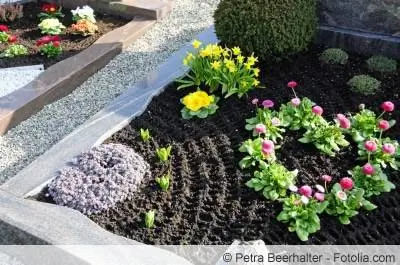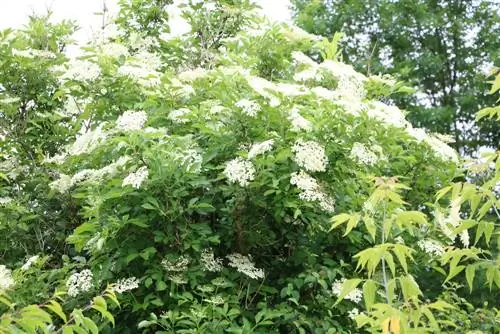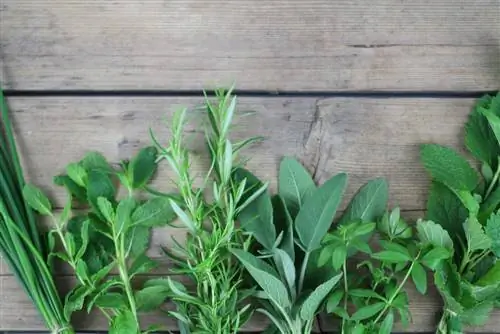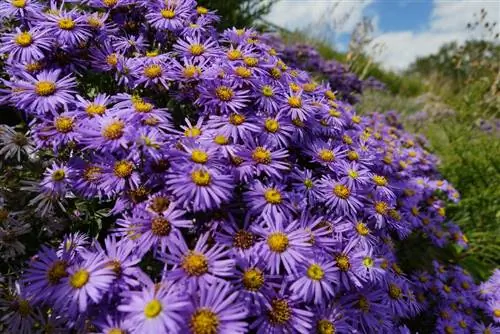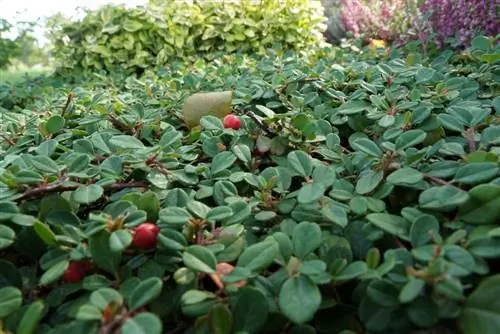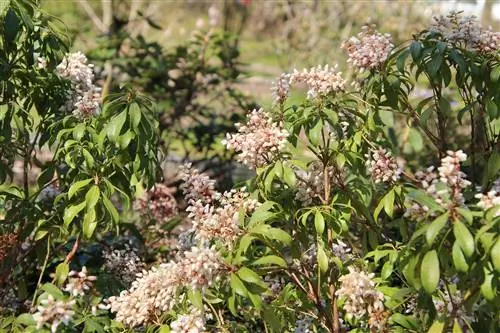- Author admin [email protected].
- Public 2023-12-17 03:39.
- Last modified 2025-01-24 12:45.
The green decoration for the final resting place has more than just visual meaning. However, it is precisely the appearance and the amount of care that are important if the focus is on beautiful memories instead of fertilizers and waste. The grave planting should therefore be selected to suit the conditions at the location. The following suggestions can help you find the right plants for sun and shade. And to create decorative compositions that also require little effort.
The grave planting zones
Three zones can be considered for planting the final resting place. The edge, the ground cover and flowering solitaires. On the one hand, this creates an orderly impression, on the other hand, weeds are suppressed and there is a clear demarcation. Depending on the location, all plants must be selected for a sunny or shady location. Otherwise, burns or dried leaves could quickly become unsightly and watering could also become an unnecessarily time-consuming undertaking.
Edge planting for sunny locations
The edge planting puts everything in a frame and also creates a clear line to the outside. The prerequisite for this, however, is that their growth is restricted and blended. A root barrier can take on this task. An annual trimming is usually sufficient to bring strongly growing shoots back to a tolerable length.
Suitable are:
- Colorful Creeping Spindle
- Sedum
- Sempervivum
Tip:
If you don't want plants as a border, you should use decorative stones. White stones, which have a diameter of around four to five centimeters, are particularly beautiful and contrast with the grave's plants.

Colorful Creeping Spindle
The evergreen creeping spindle is suitable for sunny locations if it has colorful leaves. The leaves contain less chlorophyll and therefore require more sunlight to thrive. Since it spreads quite densely and can even climb, trimming should be part of the care. However, the art of climbing can also be used by framing the gravestone on the side of the green. And the creeping spindle is also ideal as a ground cover.
Sedum
Sedum is a suitable grave plant for particularly dry and sunny locations. Frugal, long-lasting and easy to care for, its unusual appearance makes it a wonderful visual frame. Watering is hardly necessary, even in hot and rainy summers. The same applies to fertilization.
Sempervivum
Similar to Sedum, Sempervivum is hard to beat in terms of frugality. Fertilization is only necessary after several years of standing, the watering effort is surprisingly manageable and the spread can also be easily kept under control.
Ground cover for sunny positions
Ground cover plants for sunny locations fulfill several useful tasks as grave plants. On the one hand, they keep the soil free of weeds because the densely growing plants do not let any “troublemakers” through. On the other hand, they form an opaque substrate, prevent erosion during heavy rainfall and provide an attractive base for flowering plants.
Ideal are:
- variegated ivy
- Strauchveronika
- Mockberry
Colorful Ivy
Again, the brighter or more colorful the leaves, the better the ivy is suitable for sunny locations. The fast-growing plant spreads out like a carpet and is easy to care for, requires little water and can therefore survive hot summers without any problems. In addition, there are now many different cultivated forms on the market, which differ considerably not only in color but also in leaf size. This makes it possible, for example, to plant mixtures that run in shapes or lines and thus create a very attractive picture even without flowering plants.
Strauchveronika
The shrub veronica has a friendly, light green and can grow in a spherical shape or as a carpet. This offers numerous options for arrangement and decoration. It is also suitable as a ground cover and as a border plant. In any case, it is frugal and tolerates the sun.
Mockberry
The false berry or carpet berry is one of the exotic grave plants. It blooms in summer and shows bright red berries in autumn - so it is a beautiful eye-catcher in itself. Suitable for sunny and partially shaded locations, it is versatile and decorative.
Solitary plants for bright locations
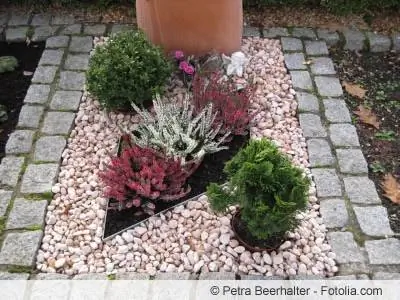
Straight-flowering plants that grow slightly higher are ideal for a solitary position on the grave. Not only plants that need a lot of sun to develop their flowers are recommended, but also undemanding varieties. They should get by with little water. Otherwise, you would have to water not just daily, but several times a day during hot periods. Otherwise the flowers would dry out quickly and would no longer be decorative.
Advisable are:
- Pentas
- Kalanchoe
- Carnation
Tip:
Plant the flower decorations separately in bowls or pots and place them in the soil. This makes it easier to change plants.
Pentas
Pentas are extremely easy to care for and do not require much water or fertilizer. They can be planted directly on the grave or in a pot. You can get both without any problem. The plants are also available in numerous colors and bloom almost continuously from spring to autumn.
Kalanchoe
The Kalachoe is a thirst artist. It can survive for a long time without watering without losing any of its beauty. It also blooms from May to October, making it a long-lasting ornament. The Kalanchoe is undemanding and blooms in numerous colors, making it ideal for bowls or pots on the gravesite. However, it can also be planted directly between the ground cover plants. Due to its low nutrient requirements, it does not become a competitor here.
Carnation
Carnations can now be found in numerous cultivated forms and colors. Double or simple, with contrasting flower edges but always fragrant, the easy-care and robust plants are wonderful as solitary plants for the final resting place. They thrive best in sun and partial shade, so they are a good choice for more than just grave plants in sunny locations.
Edge plants for shade
In the shade, plants need little water, at least they don't have to defend themselves against the blazing sun and the associated evaporation. The following are suitable as edge plants for the grave:
- green-leaved creeping spindle
- creeping gunsel
- hardworking Lieschen
Green-leaved Creeping Spindle
Green-leaved creeping spindle can easily be kept in shape with just one trimming per year, is undemanding and is even suitable for edging gravestones. It also proves to be ideal as a ground cover thanks to its dense growth.
Crawling Gunsel
It grows creeping and blooms for a long time in a rich shade of blue, can be easily kept under control and is also undemanding. Nevertheless, the creeping Günsel is quite unknown and almost exotic, not only as a grave plant.
Hardworking Lieschen
Persistent flowering from May to October - in numerous colors - is guaranteed with the hard-working Lieschen. This floral display is a rarity in the shade, so the plant is not only suitable for border planting, but also as a solitary plant.
Ground cover for shady graves
Ground cover plants don't have to be boring even in the shade, but can actually bloom and therefore be an ornamental base. Ideal are:
- green-leaf ivy
- Carpet Phlox
- hardy feather padding
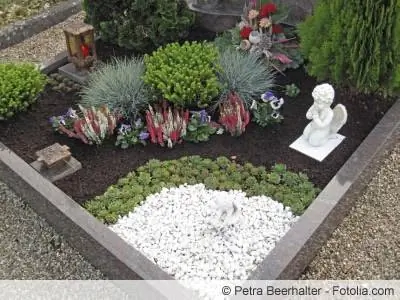
Green-leaf ivy
The darker the leaves of the ivy, the better they are for shady locations. Since they contain a lot of colorophyll, they require little sunlight. In addition to the classic varieties, it is also worth taking a look at newer cultivated forms, for example particularly small-leaved forms. Mixtures of different types of ivy are also very decorative.
Carpet Phlox
Would you like an undemanding display of flowers? The carpet phlox provides this in spring and summer and then becomes a green, dense ground cover with delicate leaves. However, it doesn't require much care and can easily survive hot summers in the shade.
Hardy feather padding
Little water, little care, great beauty - these advantages are combined with the winter-hardy feather cushion. The leaves look like miniature versions of ferns and are even sturdy. In summer there is also the decorative, delicate flower that extends over the entire ground cover.
Solitary plants for shady locations
As solitary plants for shady locations and eye-catching grave plants, you should choose plants that still produce plenty of flowers without a lot of sun. These include:
- wood anemones
- Rhododendron
- Monkshood
wood anemones
Bushweeds can easily be left to their own devices without losing their beauty and flowering potential. They thrive well in the shade and are ideal underplanting for taller plants. Culture in a bowl or pot is recommended to avoid unwanted spread.
Rhododendron
The rhododendron is not necessarily one of the easiest plants to care for, but as a solitary plant on the grave it can catch a few eyes and exudes dignity. For less effort, we recommend growing in a pot, which should, however, be placed in the ground.
Monkshood
Blue, decorative flowers and an easy-care character make monkshood a popular plant for gardens and graves. It looks particularly beautiful in combination with white-flowering plants. But be careful: Monkshood is one of the most poisonous plants and must be treated with appropriate protection.
Conclusion
If you take the lighting conditions into account when planting graves and choose them with regard to water requirements and care effort, you can create a beautiful, decorative and yet easy-care plant, even in dry phases and hot summers. The gravesite is now free for commemoration and beautiful memories and not as a high-maintenance green space.

